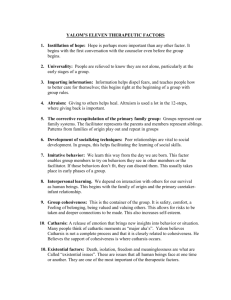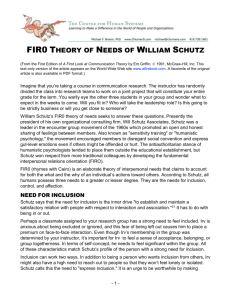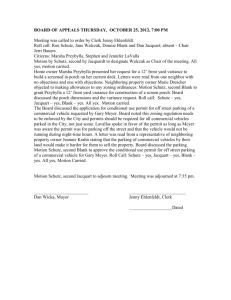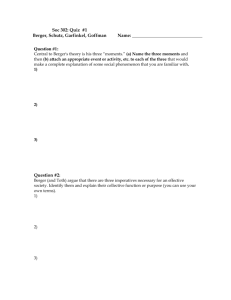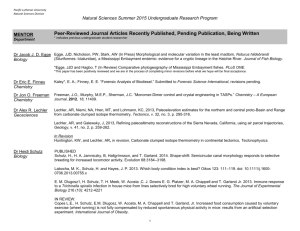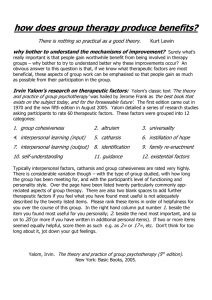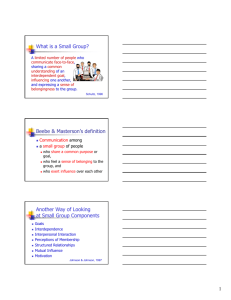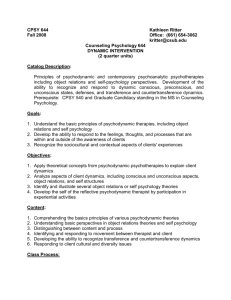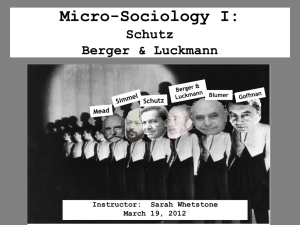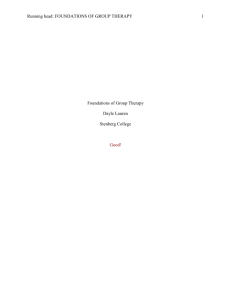2 Group Development Theories
advertisement
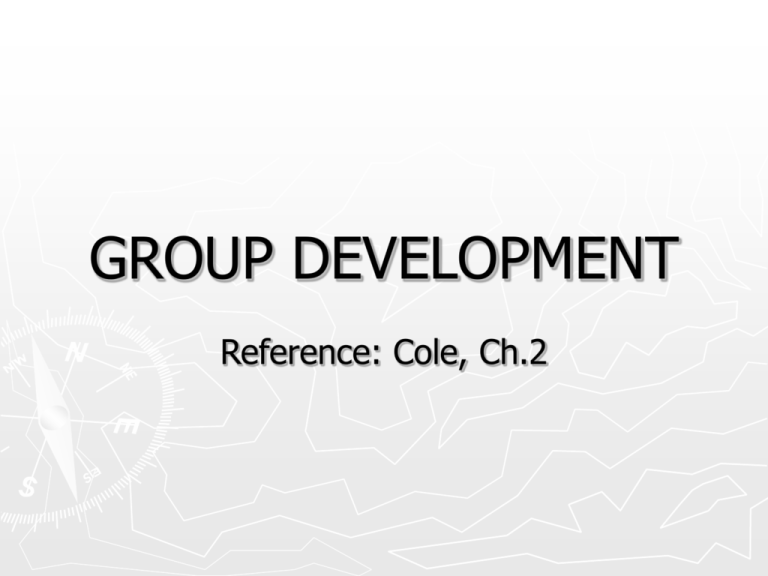
GROUP DEVELOPMENT Reference: Cole, Ch.2 Why Study Group Development? ► Research shows that groups move through predictable stages of development ► Objectives: Review theories of group development Understand optimal development of groups Know how to encourage growth in our groups Understand how to cope with blockages and obstacles Theories Stage Yalom 1 2 3 Orientation Conflict Harmony Bion Flight Schutz Inclusion Tuckman Form Fight Unite Control Affection Storm Norm 4 Maturity ….. ….. Perform Yalom Stages ► 1. ORIENTATION Hesitant participation Search for meaning Dependency on leader Leader is active Yalom, cont ► 2. CONFLICT (dominance, rebellion) “The struggle for control is present in every group” “members feel free to make personal criticism A time of “oughts” and “shoulds” The leader is challenged ► He or she doesn’t have all the answers ► Leader viewed as all-powerful, but holding back ► Members realize none of them will become therapist’s “favorite child” ► Members divided between “attackers” and “defenders” of the leader Hostility toward the therapist emerges in many forms Members have resistance to self-disclosure Yalom, cont. ► HARMONY (Development of cohesiveness) Increase in morale Increase in self-disclosure Concern over absences or missed sessions Desire to socialize outside the group Chief concern is closeness/intimacy Suppression of negative affect Mutual support Yalom, cont. ► MATURITY Cohesive aspects from previous stage continue Conflict is no longer avoided Negative emotions can now be freely expressed Problems are constructively worked through Bion (1961) ► Behavioral approach: Studied statements made in groups & categorized them into both productivity and emotional content ► Saw periodic shifts in pattern or direction ► 1. Flight – Members dependent on leader, avoid taking on responsibility. ► 2. Fight - Members attack leader or scapegoat a rival leader (member) as a flight from leader ► 3. Unite – Begins as pairing and sub-grouping; ends in stable working group with very little emotionality Schutz ► Three-dimensional theory of interpersonal behavior (The Interpersonal Underworld) ► Believed that every individual has three interpersonal needs: Inclusion, control, and affection ► Parallels the development of the child in the family Schutz, cont. ► 1. INCLUSION Will I be accepted? Where do I fit in? What can I give to this group? Will I be important? Respected? Can I be myself? How will the leader respond to me? ► Characteristics: Over-talking, individually centered behavior, territoriality, self-centered unawareness and insensitivity to others, not really listening, interpreting remarks in terms of own needs Schutz, cont. ► Inclusion, continued Leader is idealized Size up each other, question, categorize Search for similarities Concern over those who haven’t contributed Silent members can block progress of group Schutz, cont. ► 2. CONTROL Where do I stand in relation to power and authority? How much influence do I have? Will I have too much responsibility? ► Characteristics: leadership struggle Therapist viewed with mistrust, analyzing and judging members, withholding answers Leader must no show signs of defensiveness Member attempts to lead are met with severe criticism Scapegoats must be protected by therapist Schutz, cont. ► Control, cont. Members split over those who want more structure & those who want less Dependence/independence struggle Members need protection and help vs need for power & status Parallel’s “terrible twos” in childhood (Autonomy vs Shame & Doubt) Themes of dominance/conformity and aggression/submission predominate Schutz, cont. ► 3. AFFECTION Group Cohesiveness How do others feel about me? How do WE feel about each other? ► ► ► ► ► Characteristics: Expression of positive feelings, emotional investment in group, really listen to each other, direct hostility can be expressed without negative consequence, secret issues may be shared Belief that one is loved and capable of loving Real consensual validation occurs Members able to explore new behaviors Separation anxiety Schutz, cont. ► Affection is not a final phase, as setbacks occur ► Anticipation of termination can reverse the process ► Stages regress from cohesiveness when New member arrives Old member leaves Leadership changes Interruptions/gaps in meeting schedule Absences occur Tuckman ► Most recent theory, incorporates parts of previous theories ► Believes all stages occur in some way regardless of the duration of the group ► Rate of development adjusts according to time available ► Laboratory tasks (OT activities) can help groups develop more rapidly Tuckman, cont. ► 1. FORM Testing and dependence Orientation and testing regarding group task Look to therapist for guidance Attempt to gain acceptance Tuckman, cont. ► 2. STORM Intra group conflict Members become hostile toward one another Members challenge the leader Members resist structure, rules, task Members express individuality Focus on differences rather than similarities Tuckman, cont. ► 3. ► 4. NORM Development of cohesion Accept group and accept each other “warts and all” Harmony is valued & task conflicts are avoided Members are open to each other (trust) PERFORM Emotion is supportive, does not interfere with task accomplishment Can work together effectively Insights are openly discussed Members can be self-critical and attempt to change abnormal behavior Leadership Challenges ► Realize that leadership challenges are normal and predictable stages of group development ► Don’t Abdicate Invites member conflict Results in scapegoat ► Don’t Dominate Defends & strengthen autocratic leadership Members have lowered morale Encourages dependency on leader Leadership Challenges, cont. ► As OT leader, best way to handle challenges is: Share responsibility with members, assign roles, delegate Allow expression of dissention and acknowledge it Take the blows, don’t allow members to be scapegoated Make some changes in response to group Allow conflict to resolve while preserving integrity of group From Cole, M. Group dynamics in occupational therapy instructor's manual. Online document, http://www.efacultylounge.com, based on Cole, M. (2004). Group dynamics in occupational therapy, Third edition. Thorofare, NJ: SLACK Incorporated. Importance for OT Stages are predictable – as therapists we can predict what activities are appropriate for each stage, helps us plan successful groups ► Awareness of stages helps us understand what happens in OT groups ► Be aware of leader challenges & handle appropriately (fieldwork example) ► Be aware of blockages, dependence, need for structure ► Support members who take risks, monitor timing of selfdisclosure ► Design activities to help therapeutic groups reach mature state (cohesiveness) ► How Groups Reach Maturity (Things you can do in group lab right now) ► 1. Have a focus – Think about what you’d like to change, set a goal ► 2. Pay attention to feelings – Yours and other members, share feelings with group ► 3. Be an active participant – Silence may block the group in control phase ► 4. Give feedback – This builds trust ► 5. Be open to feedback – Don’t get defensive, just listen & think about it ► 6. Take responsibility for what the group accomplishes. Your actions can move the group forward… or not
